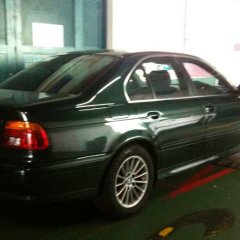Search the Community
Showing results for tags 'trains'.
-
The 1987 trains in operation since MRT was a thing will be retired. The first two new trains for the North-South and East-West MRT lines (NSEWL) have arrived in Singapore. Source: https://mothership.sg/2022/02/new-mrt-trains-replace-1987-fleet/ They are part of a fleet of 106 new trains designed in Germany and built in China. The trains were shipped to Singapore by sea. The journey took about one month to complete. Details about the new trains were shared by the Land Transport Authority (LTA) on Facebook on Feb. 21. Replace trains in use since 1987 The new rolling stock will replace trains that have been operating on the two lines since 1987 when the NSEWL began operations. The first-generation trains will be retired when the new trains enter service from the end of 2022. The new trains also highlight how the supply chain spans many countries in the northern hemisphere. “The design was conceptualised in Germany before they were manufactured and assembled in China, and their parts were sourced from various countries including United Kingdom, France and Germany,” LTA wrote. Decked out in green and red stripes, the traditional colours of NSEWL, they will serve commuters from end-2022, LTA added. The trains will undergo rigorous testing and commissioning works before they are ready. Standardised look In 2018, LTA announced that it had bought 66 new trains to replace its oldest fleet. The trains were to be made by Canadian company Bombardier Transportation, and were supposed to arrive in batches from 2021. In 2020, it was announced that a second set of 40 trains were to be bought from Bombardier to replace second- and third-generation trains on the North-South and East-West lines from 2024. The 19 second-generation trains have been operating since 1995. The 21 third-generation trains have been in service since 2000. A total of 198 trains of six different types serve the NSEWL as of 2020. In contrast, all 106 new trains will have the same design.
-
Sexual harassment on trains What would be your reply?
- 72 replies
-
- Sexual
- harassment
-
(and 1 more)
Tagged with:
-
Is it me or is it the circle line trains abit shorter than the usual ones? I notice that the circle line stations are tat small.
-
Here’s an article by Mr David Mason, an ‘ang moh’, who lives and works in Singapore for several months a year. He’s been here for so many years that he even remembers what public transport was like in the days before the MRT was built, and when there was no air-con on public buses *gasp!* Singapore’s come a long way, now there’s integrated transport hubs, sheltered link ways. And much of our public transport system now cater to those who are less mobile, e.g. wheelchair accessible public buses, green man plus which gives more ‘green time’ to seniors and those with disabilities. Our public transport system isn’t perfect and there’s the occasional hiccups, but compared to many places around the world, it’s really still ‘very good’. Source : LTA Facebook
-
Two subway trains collided in Seoul on Friday, injuring scores of people but with no immediate report of any fatalities, the emergency services said. "So far, we have a total of 78 injured, all of them lightly," a spokesman for the Seoul emergency services told AFP. One TV news channel put the number of injured at 170. News of the accident broke as the country was still reeling from a ferry disaster on April 16 that left around 300 dead or missing -- most of them schoolchildren -- after the boat capsized and sank. The tragedy triggered widespread public anger and a bout of national soul-searching as to whether the country had sacrificed safety standards in its rush for economic development. The details of Friday's subway accident were not immediately clear, but it appeared that one train had stopped in, or close to, Sangwangsimni station in eastern Seoul when the second train ran into its back. Source: http://www.channelnewsasia.com/news/asiapacific/dozens-injured-as-subway/1092652.html
-
http://www.tremeritus.com/2014/03/02/asbestos-found-on-china-made-trains-in-nz-australia/ Asbestos found on China-made trains in NZ & Australia March 2nd, 2014 | Author: Editorial Singapore's new Downtown Line uses trains which are made in China (Photo: LTA) The New Zealand Herald reported today (2 Mar) that asbestos found on Chinese-made trains used by KiwiRail could cost workers’ lives (‘Asbestos on Chinese-made trains could cost workers lives‘). NZ Herald reported that 40 of the NZ state-owned company’s trains were taken out of action following the discovery of the potentially deadly material in a soundproofing compound inside one of the vehicles on Friday (28 Feb). Initial tests had confirmed the asbestos was contained and not a health risk, KiwiRail chief executive Peter Reidy said. However, further testing will be carried out to see if the material had leaked into the air or onto surfaces of any of the trains. Many of the NZ rail workers are concerned. The NZ’s Rail and Marine Transport Union (RMTU) said the situation had left many workers fearing for their health and that of their families. Mr Wayne Butson, general secretary of RMTU, told the media: If these locos had been made in Dunedin (in NZ), or even in any other first world country, we wouldn’t be putting up with this rubbish. It’s pretty symptomatic of why most Kiwis are sceptical about anything that comes out of China. Earlier KiwiRail said the inclusion of asbestos in the trains was in breach of a contract specification which clearly stated the material should not be used. “We are clearly very disappointed with this situation and working closely with the manufacturers to understand how this could possibly have occurred. They have taken full responsibility for this and have undertaken to do whatever is necessary to rectify the situation as quickly as possible for us,” Mr Reidy said. Reporting the same news, the Australian Broadcasting Corporation (ABC) revealed that the trains used by KiwiRail were made by Chinese manufacturer Dalian Locomotive and Rolling Stock Co Ltd [Link]. ABC reported that the Chinese manufacturer has since confirmed it used chrysotile, or white asbestos, in a sound-proofing compound which is either coated with paint or sealed beneath the panelling. Last November, ABC reported that 10 freight locomotives made by China Southern Rail were also pulled from service in Australia after workers were exposed to potentially deadly asbestos dust [Link]. In Singapore, the new trains plying the Downtown Line (DTL) are also made in China. A total of 73 train sets consisting of 3 cars each were purchased by the Land Transport Authority (LTA) at a cost of approximately $571 million in a public tender in 2008 (‘Made-in-China trains for Downtown Line unveiled‘). LTA had previously assured the public that the made-in-China DTL trains meet rigorous safety standards (‘LTA: Made-in-China trains meet rigorous safety standards‘). The DTL trains were manufactured in Changchun, Jilin Province of China. LTA said that the trains were assembled in China, but their components come from 8 different countries, including China (which manufactured the car body), Sweden, UK, France, Spain, the Czech Republic and Germany. The first stage of DTL or DTL1 opened in December last year, linking 6 stations from Bugis to Chinatown. It is not known if asbestos has also been used for soundproofing in the China-made DTL trains. Asbestos became increasingly popular among manufacturers and builders in the late 19th century because of its sound absorption, average tensile strength, resistance to fire, heat, electrical and chemical damage, and, most important of all, affordability. However, prolonged inhalation of asbestos can cause serious illnesses including malignant lung cancer, mesothelioma and asbestosis. These asbestos-related diseases will not affect people immediately but usually later on in life. The trade and use of asbestos have been restricted or banned in many countries.
-
Hello, not sure if it is just me or everyone felt the same but i realised that nowadays since 2-3months back our train service is getting worse. Morning have to wait for 2-3 trains before manage to squeeze in and then in the evening another rounod of wait for 4-5 trains squeeze like sardines again. Working life in SG sucks without a car!
-
downtown line trains arrived can anyone explains why are we paying the top money for PRC stuff? another cost cutting scheme from the SCORLARS?
-
How to fit 266 people in one carriage
-
[thumbsup] MIC for once got standard.. [thumbsup]
-
http://news.asiaone.com/News/Latest+News/S...111-321097.html so wtf are they trying to do? encourage ppl to leave work early so that thery can avoid the jam? TRAIN commuters who travel during peak morning periods could get more monetary rewards if they change their travel times to off-peak periods. These rewards, that can come in the form of stored value, are redeemable using credits which commuters earn when they use their ez-link cards to travel during non-peak commutes. This is part of a research study conducted by the National University of Singapore (NUS) and Stanford University and supported by the Land Transport Authority (LTA). The six-month project aims to encourage off-peak commutes to reduce overcrowding on trains, and to study the effect of monetary incentives on passenger travel behaviour. Commuters who participate in the project can earn one credit point for every kilometre travelled during the peak-hour period between 7.30am and 8.30am. For non-peak hours between 6.30am and 7.30am, and 8.30am and 9.30am, they will get three credits per kilometre. Additionally, pre-selected "boost days" will allow commuters to get five credits for off-peak morning commutes. These credits can be exchanged for cash value in their ez-link cards on a monthly basis through AXS machines. Every 100 credits, or 100 kilometres travelled, will translate to $1. Alternatively, commuters can try to get more cash value for their cards by using their credits to play an online mini-game. Researchers behind the project aim to enlist the help of 20,000 people for the $450,000 project. During a media briefing at NUS yesterday, Professor Balaji Prabhakar from Stanford University said that a shift of 10 per cent in the number of commuters who travel during peak periods will "lead to a sizeable reduction" of passengers on board trains. Drawing from previous studies in India and the United States where similar incentivised approaches yielded positive results, Prof Balaji said: "We believe incentives are effective in changing the actions that people take on an everyday basis." Currently, SMRT has a discount scheme that offers passengers a rebate of up to 30 cents on their fares if they travel before 7.45am and exit at stations in the city. It was launched in October last year. LTA, which pumped $263,000 into the project, said such initiatives would allow better evaluation of incentive programmes and their effectiveness in easing the travel crunch on the rail network here. Its group director for corporate planning and research, Mr Lew Yii Der, said: "Travel-demand management is an area LTA has been actively exploring as it encourages more optimal use of public-transport capacity." Commuters my paper spoke to welcomed the initiative, saying it is a good way to ease the overcrowding on trains. Undergraduate Bruce Lim, 24, explained: "You are technically paying people just to adjust their trips slightly. "I think it's a good idea; hopefully, people will make the effort to make a change."
-
MRT faults: Real action needed Letter from Prem Singh Maybe it is time to ask that a Government committee, comprising a spectrum of knowledgeable individuals, be set up to actually look into the feasibility of nationalising our public transport. Too many things have gone wrong this year with our Mass Rapid Transit system. Commuters
-
http://www.channelnewsasia.com/stories/sin...1145164/1/.html Fares for buses and trains to go up Posted: 05 August 2011 1018 hrs SINGAPORE: Public transport fares will increase from October 8 - concurrent with the full opening of the Circle Line. The Public Transport Council (PTC) has decided to grant an overall adjustment of one per cent. The amount is significantly less than the maximum fare adjustment of 2.8 per cent the public transport operators (SBS Transit and SMRT) wanted. Adults using ezlink cards for buses and trains will see a two cents increase per journey. Fares for senior concession card holders will increase by one cent per journey. But concession hours for senior citizens will be extended to the full-day throughout the week. Their fares on the North East Line and Circle Line will also be adjusted downwards. An estimated four in 10 senior citizens will see fare savings. There will be no change to child or student concession card fares. As for those paying in cash, adult commuters will see their fares increase by 10 cents per trip across the board. There will be no change to senior citizen and child or student cash fares. Overall, the average increase translates to about 15 cents more, per week, for the 85 per cent of commuters who will be affected. - CNA/cc Just as everyone guess, PTC is just another toothless tiger. on one hand try to please the public, on the other try to support the private operators....
-
http://www.channelnewsasia.com/stories/sin.../427284/1/.html LTA awards S$368 million contract for 22 new trains SINGAPORE: The Land Transport Authority has awarded a S$368 million contract for 22 new trains for the North-South and East-West Lines. The trains are scheduled to be progressively delivered to Singapore from 2011 till 2012. With the 22 new trains and modifications for an additional track at Jurong East station, LTA says commuters will experience a shorter waiting time and a more comfortable ride on trains during peak periods. The modifications and new trains will increase the capacity of the North-South, East-West Lines by about 15 per cent and enable the lines to meet projected demand till 2020. 1) shorter waiting time maybe 2) more comfortable ride??? how to when smrt already remove most of the seats in current trains inorder to squeeze in more passengers and are there any train stewardess serving me or massaging me during the journey? 3) spend S$368 million just to increase the capacity by abt 15%, well spent and wise??? 4) to meet the projected demand till 2020 whereas the trains will only be delivered 2011/2012, does that mean the trains will only be used for abt 8-9 yrs before the next change?
-
From ST Forum MY 15-YEAR-OLD nephew has been an avid BMX stunt cyclist for more than a year. He meets his friends about three times a week at the Youth Park in Somerset Road. This is a healthy and exciting sport for youngsters like him and we applaud the efforts by the Ministry of Community Development, Youth & Sports and the National Youth Council to provide a place for extreme sports for bikers and skaters since 2004. However, there is an important issue regarding transport for these cyclists which I would like the authorities to address. My nephew has told me that in the past few months, he and his friends have been stopped many times by officers at MRT stations and told not to take their bicycles onto the train. Please note that these bikes have been dismantled and folded neatly into special BMX bags which the bikers carry on their shoulders. The bags have clear BMX logos to indicate a bicycle inside. When they explained they were only carrying bicycles to the Youth Park at Somerset, they were asked to leave the MRT station and find another means of transport. They were even threatened with a fine if they continued to take their bikes on the train. Getting on the bus has also been a problem for these youngsters. Bus drivers have asked them rudely what they were carrying in their big black bags. Some have asked them to leave the bus. So it seems the only means of public transport for this group of bikers is by taxi. This does not make sense, as the Youth Park is located in the heart of town in Orchard Road next to Somerset MRT station. In fact, this is what my nephew has done for the past few months, spending a lot of money simply to pursue the sport he loves. Ng Lai Yien (Ms)


.png)










